

MoSCoW Prioritisation method. Home > Requirements > MoSCoW Prioritisation To be successful projects need to be properly prioritised for both the requirements and the main project objectives.
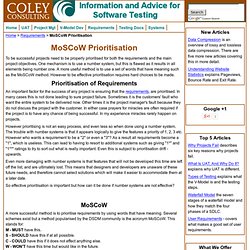
One mechanism is to use a number system, but this is flawed as it results in all elements being number one. A more useful method is to use a set of words that have meaning such as the MoSCoW method. However to be effective prioritisation requires hard choices to be made. Prioritisation of Requirements An important factor for the success of any project is ensuring that the requirements, are prioritised. However prioritising is not an easy process, and even less so when done using a number system. Even more damaging with number systems is that features that will not be developed this time are left off the list, and are ultimately lost.
So effective prioritisation is important but how can it be done if number systems are not effective? MoSCoW. How to write a software requirements specification. By Robert Japenga What Makes a Great Software Requirements Specification?
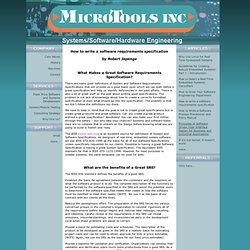
There are many good definitions of System and Software Requirements Specifications that will provide us a good basis upon which we can both define a great specification and help us identify deficiencies in our past efforts. There is also a lot of great stuff on the web about writing good specifications. The problem is not lack of knowledge about how to create a correctly formatted specification or even what should go into the specification. The problem is that we don't follow the definitions out there. We have to keep in mind that the goal is not to create great specifications but to create great products and great software. Paper for Topic: Requirements & Specifications. Carnegie Mellon University 18-849b Dependable Embedded Systems Spring 1999 Author: Eushiuan Tran Abstract: Defining requirements to establish specifications is the first step in the development of an embedded system.

However, in many situations, not enough care is taken in establishing correct requirements up front. This causes problems when ambiguities in requirements surface later in the life cycle, and more time and money is spent in fixing these ambiguities. Therefore, it is necessary that requirements are established in a systematic way to ensure their accuracy and completeness, but this is not always an easy task. Contents: Introduction. Excel Software Price Sheet. Www.ict-papyrus.eu/files/Papyrus-D2.2-v02.1.pdf. User Requirements Specification. (URS) Without doubt the User Requirements Specification (URS), is the most critical of documents and yet, the most often bungled.
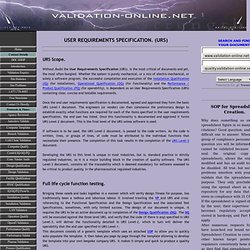
Whether the system is purely mechanical, or a mix of electro-mechanical, or solely a software program, the successful compilation and execution of the Installation Qualification (IQ) (for installation), Operational Qualification (OQ) (for functionality) and the Performance / Product Qualification (PQ) (for operability), is dependent on an User Requirements Specification (URS) containing clear, concise and testable requirements. Once the end user requirements specification is documented, agreed and approved they form the basic URS Level-1 document. The engineers (or vendor) can then commence the preliminary design to establish exactly what functions are required for each of the items specified in the user requirements specification, the end user has listed.
Once this functionality is documented and approved it forms URS Level-2 document. They must be comprehensive. User Requirements - three areas to include and one to avoid. Home > Requirements > User Requirements A good set of user requirements are needed for any project, especially computer system projects, to be successful.
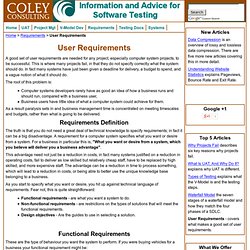
This is where many projects fail, in that they do not specify correctly what the system should do. In fact many systems have just been given a deadline for delivery, a budget to spend, and a vague notion of what it should do. The root of this problem is: Computer systems developers rarely have as good an idea of how a business runs and should run, compared with a business user,Business users have little idea of what a computer system could achieve for them.
As a result paralysis sets in and business management time is concentrated on meeting timescales and budgets, rather than what is going to be delivered. Requirements and Design - What the differences are between them. Home > Requirements > Requirements and Design When writing requirements it is very easy to end up producing a design rather than specifying what is wanted.
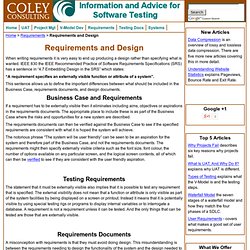
IEEE 830 the IEEE Recommended Practice of Software Requirements Specifications (SRS) has a sentence in “4.7 Embedding Design in the SRS” which states: “A requirement specifies an externally visible function or attribute of a system”. This sentence allows us to define the important differences between what should be included in the Business Case, requirements documents, and design documents. Business Case and Requirements If a requirement has to be externally visible then it eliminates including aims, objectives or aspirations in the requirements documents.
Is not available. User Requirements Specifications (User Specs, URS) The User Requirements Specification describes the business needs for what users require from the system.
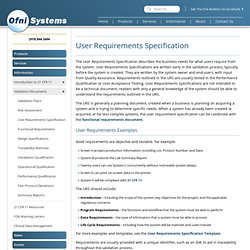
User Requirements Specifications are written early in the validation process, typically before the system is created. They are written by the system owner and end-users, with input from Quality Assurance. User Requirements Specification (URS)